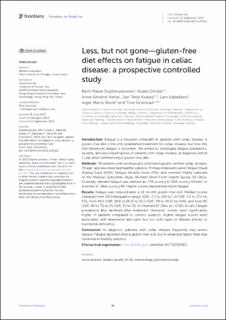| dc.contributor.author | Skjellerudsveen, Berit Mære | |
| dc.contributor.author | Omdal, Roald | |
| dc.contributor.author | Hetta, Anne Kristine | |
| dc.contributor.author | Kvaløy, Jan Terje | |
| dc.contributor.author | Aabakken, Lars | |
| dc.contributor.author | Skoie, Inger Marie | |
| dc.contributor.author | Grimstad, Tore Bjørn | |
| dc.date.accessioned | 2024-02-13T12:58:21Z | |
| dc.date.available | 2024-02-13T12:58:21Z | |
| dc.date.created | 2023-10-26T10:42:28Z | |
| dc.date.issued | 2023 | |
| dc.identifier.issn | 2296-858X | |
| dc.identifier.uri | https://hdl.handle.net/11250/3117311 | |
| dc.description.abstract | Introduction: Fatigue is a frequent complaint in patients with celiac disease. A gluten-free diet is the only established treatment for celiac disease, but how this diet influences fatigue is uncertain. We aimed to investigate fatigue prevalence, severity, and associated factors in patients with celiac disease, at diagnosis and at 1 year after commencing a gluten-free diet.
Methods: 78 patients with serologically and histologically verified celiac disease, 78 age- and sex-matched healthy subjects. Primary endpoints were Fatigue Visual Analog Scale (fVAS), Fatigue Severity Scale (FSS), and inverted Vitality subscale of the Medical Outcomes Study 36-Item Short-Form Health Survey (SF-36vs). Clinically relevant fatigue was defined as: FSS score ≥ 4, fVAS score ≥ 50 mm, or inverted SF-36vs score ≥ 65. Higher scores represented more fatigue.
Results: Fatigue was reduced after a 12-month gluten-free diet. Median scores changed from 3.8 (interquartile range [IQR]: 2.2 to 4.8) to 1.9 (IQR: 1.4 to 3.5) for FSS, from 44.5 (IQR: 18.8 to 66.0) to 15.5 (IQR: 7.8 to 43.3) for fVAS, and from 65 (IQR: 40 to 75) to 35 (IQR: 25 to 55) for inverted SF-36vs (p < 0.001 for all). Fatigue prevalence also declined after treatment. However, scores were significantly higher in patients compared to control subjects. Higher fatigue scores were associated with depression and pain, but not with signs of disease activity or nutritional deficiency.
Conclusion: At diagnosis, patients with celiac disease frequently had severe fatigue. Fatigue declined after a gluten-free diet, but it remained higher than that observed in healthy subjects. | en_US |
| dc.language.iso | eng | en_US |
| dc.publisher | Frontiers | en_US |
| dc.rights | Navngivelse 4.0 Internasjonal | * |
| dc.rights.uri | http://creativecommons.org/licenses/by/4.0/deed.no | * |
| dc.title | Less, but not gone—gluten-free diet effects on fatigue in celiac disease: a prospective controlled study | en_US |
| dc.type | Journal article | en_US |
| dc.type | Peer reviewed | en_US |
| dc.description.version | publishedVersion | en_US |
| dc.rights.holder | Copyright 2023 The Author(s) | en_US |
| dc.source.articlenumber | 1242512 | en_US |
| cristin.ispublished | true | |
| cristin.fulltext | original | |
| cristin.qualitycode | 1 | |
| dc.identifier.doi | 10.3389/fmed.2023.1242512 | |
| dc.identifier.cristin | 2188716 | |
| dc.source.journal | Frontiers in medicine | en_US |
| dc.identifier.citation | Frontiers in medicine. 2023, 10, 1242512. | en_US |
| dc.source.volume | 10 | en_US |

